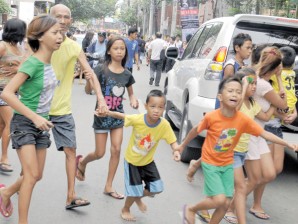Aftershocks to continue in next few weeks—Phivolcs

QUAKE PANIC Residents in Cebu City run scared as reports of a tsunami swept the city after a 6.9-magnitude earthquake shook the Central Visayas metropolis on Monday. The earthquake’s epicenter was placed near Tayasan town in Negros Oriental. The Philippines lies in the Pacific “Ring of Fire” and is prone to earthquakes and volcanic eruptions. AFP
Though aftershocks would continue to be felt in the next few weeks in Negros and Cebu provinces that were jolted by the 6.9-magnitude earthquake on Monday, these would not be as strong, according to the Philippine Institute of Volcanology and Seismology (Phivolcs).
Still, residents would do well to be cautious, especially when returning to structures that were damaged by the temblor that was felt the strongest on Monday at a “destructive” intensity 7.
The Phivolcs sent a team on Tuesday to the Visayas to study the cause of the earthquake and to assess the damage it had wrought, according to a Phivolcs senior science research specialist, Enrico Mangao.
Mangao said aftershocks were expected because the plates that were disrupted during the earthquake were still settling. As long as these have not settled, aftershocks would continue.
Previously unknown
Article continues after this advertisementThe aftershocks could last a few weeks because of the high magnitude of the main earthquake.
Article continues after this advertisementThe quake was caused by a “blind thrust fault,” or one that has no surface manifestation. This means this was not previously known.
Mangao said that when Monday’s quake happened, Phivolcs experts debated on which fault had caused the event. But they could not trace it to a specific fault.
The Negros-Cebu areas affected by Monday’s quake had not experienced such a strong temblor before, he noted.
The aftershocks are not expected to reach a magnitude of 6.9, according to Mangao. They would have a magnitude of 3 to 4 and could go lower as the days go by.
The strong aftershock on Monday night that registered a magnitude of 6.2 was a rarity, he said.
1,009 aftershocks
As of 4 p.m. Tuesday, 1,009 aftershocks had been recorded, though most of them were not felt. The highest magnitude of an aftershock recorded Tuesday was 4.
Mangao said the areas that could expect to feel the aftershocks were the same ones that were most affected by Monday’s earthquake.